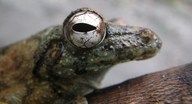|
Description
A large frog (males 44-49 mm, females 51-60 mm) from western and central forests with full webbing and a tarsal fold. Dorsal surfaces grey or greyish green, sometimes with indistinct darker marbling. Throat and ventrum white. Underside of limbs and inside of mouth and tongue bright bluish green. The males have no visible gular pouch but have white nuptial pads on 1st and 2nd finger (Schiøtz 1999).
Distribution and Habitat
Country distribution from AmphibiaWeb's database: Cameroon, Central African Republic, Congo, Congo, the Democratic Republic of the, Cote d'Ivoire, Gabon, Ghana, Guinea, Nigeria, Sierra Leone, Uganda
A forest species found throughout West Africa as far as Uganda.
Life History, Abundance, Activity, and Special Behaviors
Males call from branches in dense forest. The voice is very quiet and inconspicuous and consists of two motifs: a series of clicks, varying greatly in number but with a rate of about 5 per second, and a buzzing. The voices of frogs from Uganda were noted as being similar to those from West Africa.
Malcolm Coe (1967) observed and described foam-nest building in Chiromantis rufescens as communal between a single female and at least three males. The nests were large enough to accommodate 200 eggs. This may be particular to this C. rufescens as previous observations of other Chiromantis species (such as C. petersii and C. xerampelina) created foam nests only in pairs.
Foam nests with eggs always occur above water, often above very small, temporary water bodies such as elephant footprints. After 5 to 8 days the tadpoles wriggle their way through the hardened shell of the nest and drop into the water (Schiøtz 1999).
Larva
The tadpoles are uniform grey and have a round body and a rather short tail. The tooth formula is 1,4+4/1+1,2 or 1,3+3/1+1,2 (Schiøtz 1999). Comments
The original account was taken from "Treefrogs of Africa" by Arne Schiøtz with kind permission from Edition Chimaira publishers, Frankfurt am Main.
References
Coe, M (1967). "Co-operation of Three Males in Nest Construction by Chiromantis rufescens Gunther (Amphibia : Rhacophoridae)." Nature, 214, 112–113. [link]
Schiøtz, A. (1999). Treefrogs of Africa. Edition Chimaira, Frankfurt am Main.
Originally submitted by: Arne Schiøtz (first posted 2000-12-25)
Edited by: Kellie Whittaker, Michelle S. Koo (2022-08-18)Species Account Citation: AmphibiaWeb 2022 Chiromantis rufescens <https://amphibiaweb.org/species/4376> University of California, Berkeley, CA, USA. Accessed May 12, 2025.
Feedback or comments about this page.
Citation: AmphibiaWeb. 2025. <https://amphibiaweb.org> University of California, Berkeley, CA, USA. Accessed 12 May 2025.
AmphibiaWeb's policy on data use.
| 